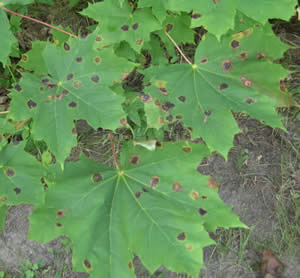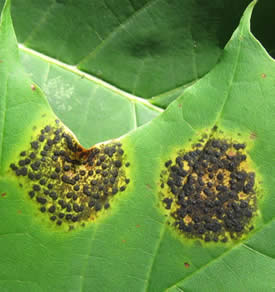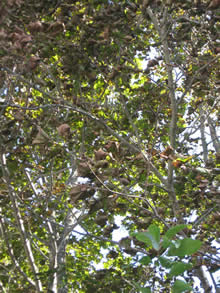DACF Home → Bureaus & Programs → Maine Forest Service →Forest Health & Monitoring → Forest Pest Index → Tar Leaf Spot of Norway Maple
Tar Leaf Spot of Norway Maple
Rhytisma acerinum
(Text adapted from Conditions Report No. 5, 2009)

There are several different fungi that can cause tar leaf spot diseases. The three fungi affecting maple are in the genus Rhytisma. All species of maples in Maine can be affected by tar spot, but the particular pathogen that is most damaging to Norway maples is Rhytisma acerinum. The tar spots that can occur on sugar maple, red maple, and our other native maple species is caused by one of two other species of Rhytisma (R. americanum, and R. punctatum). Tar leaf spot diseases that occur on our native maple species are occasionally observed, but cause inconsequential damage.

Leaf infection can begin in early spring, as the leaves are expanding, and can continue into the early summer. Long periods of wet weather including fog, mist and rain, and other conditions that retard leaf drying such as dense continual shading or cloudy weather highly favor the leaf infection process.
As the infection develops during the spring, small yellow spots appear on the leaves. Eventually, by mid- to late summer, the spots develop black, tar-like stromata, the spore-producing structures of the fungus. Leaves with multiple infections eventually turn brown, and drop prematurely from the tree.
The good news in all of this is that the disease, even though aesthetically damaging to ornamentals and urban and residential street trees, has little detrimental effect on the long-term health of the affected trees. Infected leaves retain most of their photosynthetic capabilities throughout most of the growing season. The buds for growth next year have already been set. Leaf drop is late enough in the season so that a re-foliation by the tree is not triggered. This means that the energy reserves already stored will be sufficient to allow the tree to develop normally next spring.

Norway maple is an exotic tree species. It is found in Maine as an ornamental or street tree in residential or city communities or as an invasive species in the patches of forestland within the same communities. As a rule, it does not occur in more rural forestland, and it should not because of its invasive habit.
Management or control of tar leaf spot is rarely required. There are fungicides that are available and effective, but applications must be made in the early spring, before leaf infections begin (early May). Several applications may be needed, especially if rainy periods extend through the spring and into the early summer, making control a costly proposition. Raking prematurely fallen, infected leaves is a sound sanitation practice, but leaves should be removed from the property or burned (where permissible) to prevent the fungus from re-infecting new leaves the following spring. The fungus will survive the winter in fallen leaves. Removing the leaves to a municipal composting facility is also recommended. If composting the leaves on-site, the leaf piles should be buried, or covered with a thin layer of soil or a dense layer of grass clippings or other compost, to prevent the fungus from spreading next spring. This sanitation practice will help to reduce infections the next spring, but will not eliminate the disease entirely.
MAINE DEPARTMENT OF AGRICULTURE, CONSERVATION AND FORESTRY
Maine Forest Service - Forest Health and Monitoring Division
January 2013